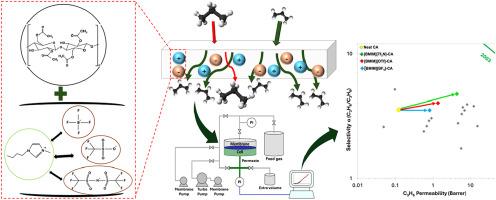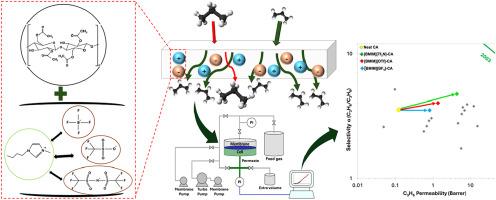剪裁的热,机械和气体输送性能的醋酸纤维素膜与离子液体有效的丙烯/丙烷分离
IF 4.5
2区 化学
Q2 POLYMER SCIENCE
引用次数: 0
摘要
鉴于设计低能耗和更清洁的烯烃净化技术的重要性,目前的工作旨在系统地加强对烯烃/石蜡气体的分离,即丙烯/丙烷。为了实现这一目标,通过将纤维素醋酸酯(CA),一种碳水化合物为基础的生物聚合物,与三种不同的非质子离子液体(il)混合,包括[BMIM]+[BF4]-, [BMIM]+[OTf]-和[BMIM]+[Tf2N]-作为添加剂,在10-30%的浓度范围内具有增塑剂作用,制成各种混合膜。通过DSC和TGA(热性能)、拉伸测试(力学性能)、x射线衍射和SEM(结构性能)对这些膜进行了广泛的物理化学表征,结果表明,由于il和CA官能团之间的相互作用,il在聚合物基体中分散得很好。与纯膜相比,ILs的加入增强了混合膜的气体传输性能,通常提高了它们的渗透性。其中,30% [BMIM]+[Tf2N]-的掺入使C3H6的通透性比纯CA膜提高了35倍,C3H6/C3H8的选择性提高了近2倍。这些结果表明,离子液体掺杂的醋酸纤维素膜是有效分离丙烯/丙烷气体对的潜在候选膜。本文章由计算机程序翻译,如有差异,请以英文原文为准。


Tailoring the thermal, mechanical, and gas transport properties of cellulose acetate membranes with ionic liquids for efficient propene/propane separation
In light of the importance of designing less energy-intensive and cleaner technologies for olefin purification, the current work aims to systematically enhance the separation of a challenging pair of olefin/paraffin gases, namely propene/propane. To achieve this goal, various blended membranes are fabricated by mixing cellulose acetate (CA), a carbohydrate-based biopolymer, with three different aprotic ionic liquids (ILs) including [BMIM]+[BF4]-, [BMIM]+[OTf]-, and [BMIM]+[Tf2N]-, which are used as additives, with a plasticizer effect, at concentrations in the range of 10–30%. Extensive physicochemical characterization of these membranes by DSC and TGA (thermal properties), Tensile tests (mechanical properties), X-ray diffraction and SEM (structural properties) show that ILs are well-dispersed within the polymeric matrix owing to the interactions between the ILs and CA functional groups. The incorporation of ILs leads to enhanced gas transport properties of the blended membranes compared to the neat one, generally improving their permeability. In particular, the blended membrane, incorporated with 30 % of [BMIM]+[Tf2N]-, increased the C3H6 permeability by 35 times and the C3H6/C3H8 selectivity by nearly two times compared to the neat CA membrane. These results suggest that ionic liquid-doped cellulose acetate membranes are potential candidates for efficiently separating the propene/propane gas pair.
求助全文
通过发布文献求助,成功后即可免费获取论文全文。
去求助
来源期刊

Polymer
化学-高分子科学
CiteScore
7.90
自引率
8.70%
发文量
959
审稿时长
32 days
期刊介绍:
Polymer is an interdisciplinary journal dedicated to publishing innovative and significant advances in Polymer Physics, Chemistry and Technology. We welcome submissions on polymer hybrids, nanocomposites, characterisation and self-assembly. Polymer also publishes work on the technological application of polymers in energy and optoelectronics.
The main scope is covered but not limited to the following core areas:
Polymer Materials
Nanocomposites and hybrid nanomaterials
Polymer blends, films, fibres, networks and porous materials
Physical Characterization
Characterisation, modelling and simulation* of molecular and materials properties in bulk, solution, and thin films
Polymer Engineering
Advanced multiscale processing methods
Polymer Synthesis, Modification and Self-assembly
Including designer polymer architectures, mechanisms and kinetics, and supramolecular polymerization
Technological Applications
Polymers for energy generation and storage
Polymer membranes for separation technology
Polymers for opto- and microelectronics.
 求助内容:
求助内容: 应助结果提醒方式:
应助结果提醒方式:


